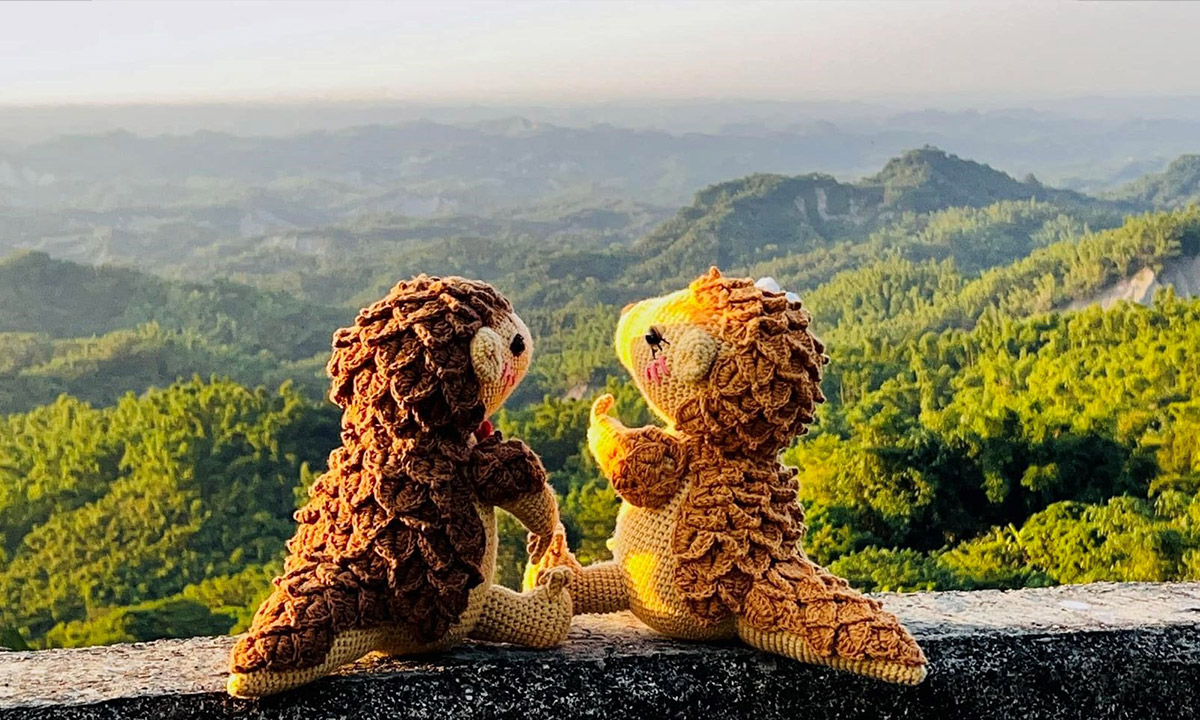
Ah-Jia and Xiao-Qi (hand-knitted plush toys), the main characters of the pangolin wedding in Longci badlands. (Provided by Tainan Community College)
In a lively traditional wedding held in the outskirts of Tainan and Kaohsiung, the protagonists were no ordinary couple, but rather pangolins — Ah-Jia and Xiao-Qi — a conservation species of the badlands.
Supported by the Wistron Fundation, the Tainan Community University, and Matoushan Nature and Humanity Association jointly organized a unique wedding ceremony. Professor Yueh-Fong Chen, a pioneer of Taiwan's environmental movement, served as the officiator, while Professor Shew-Jiuan Su of the Department of Geography at National Taiwan Normal University acted as the matchmaker. The pangolin plush dolls, Ah-Jia and Xiao-Qi, representing the Mudstone Badland Geopark Kaohsiung (including the Matoushan mudstone area) in Kaohsiung and Longci-Niupu Badland Geopark in Tainan respectively, were the main stars of the wedding. The two adjacent geological parks were about to become “in-laws” today.
Farewell to Mother Earth — Residents Present Six Gifts
The bridal team set off from the Niupu badlands, passing by temples and mountaintops such as Qing-shui Temple, Ling-yin Temple, Shannan Temple, and Yinding Mountain, bidding farewell to the mountain peaks and local deities who are guardians of the region. Each of these places is not only a scenic spot in the badlands, but also a center of religious belief and has a deep historical background. The temple managers who guide the tours are all volunteers from Tainan Community College and Matoushan Nature and Humanity Association, as well as citizen investigators of the pangolin ecology survey team. For today's celebration, the Tainan Community University, representing the bride's side, has prepared six gifts — Taiwanese termite with termite mushrooms, cocktail ant nest, Longci mudstone, pangolin doll bed, dog-beating stick, and bamboo tracking device. Representing the food, habitat, nursing environment, and a means to counter roaming dogs that threaten the pangolins, these six gifts served as a medium to convey ecological knowledge to the general public.
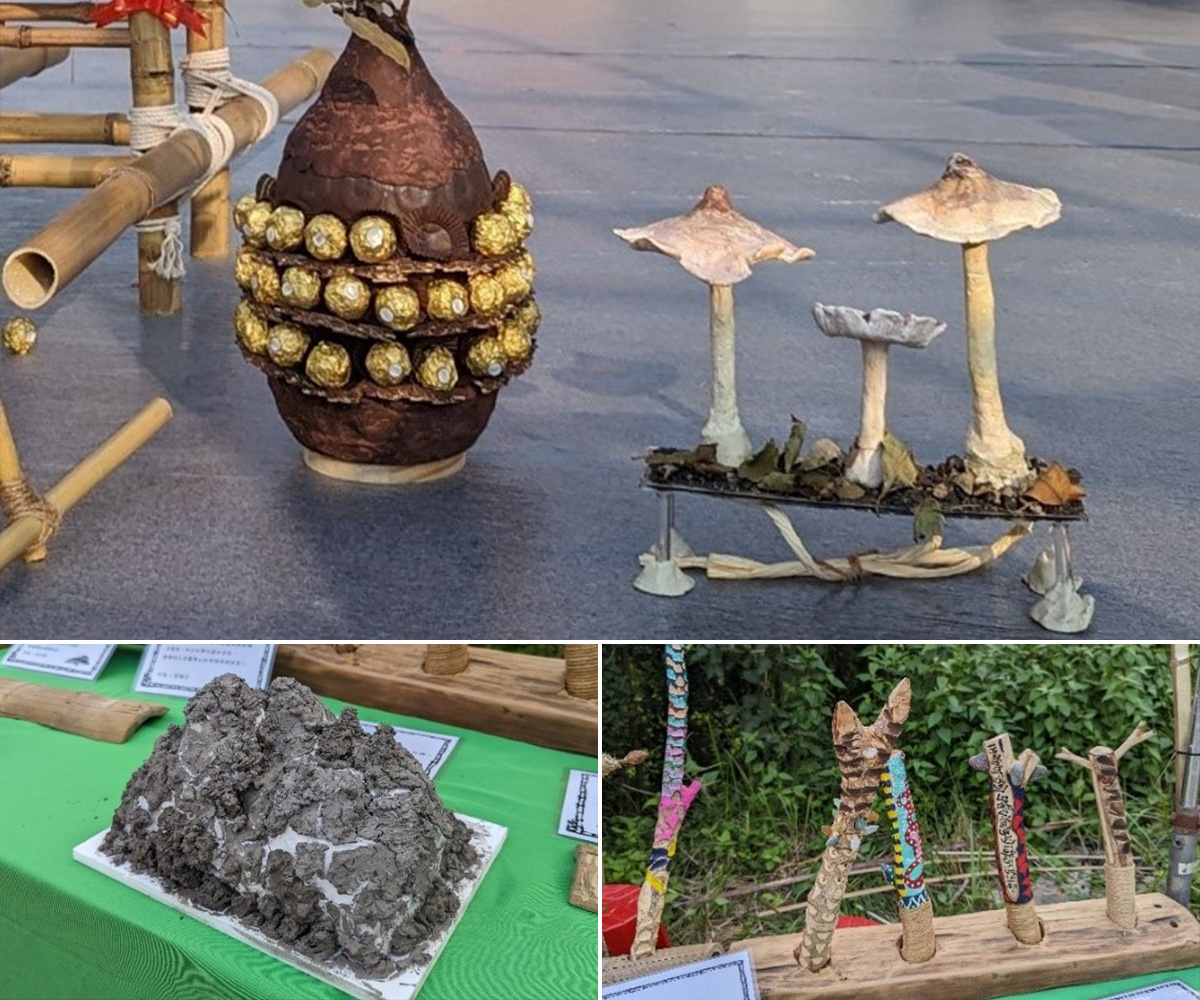
Six gifts - cocktail ant nest (upper left) and termite mushroom models (upper right). Longci mudstone model (bottom left) and creative dog-beating bamboo stick (bottom right).
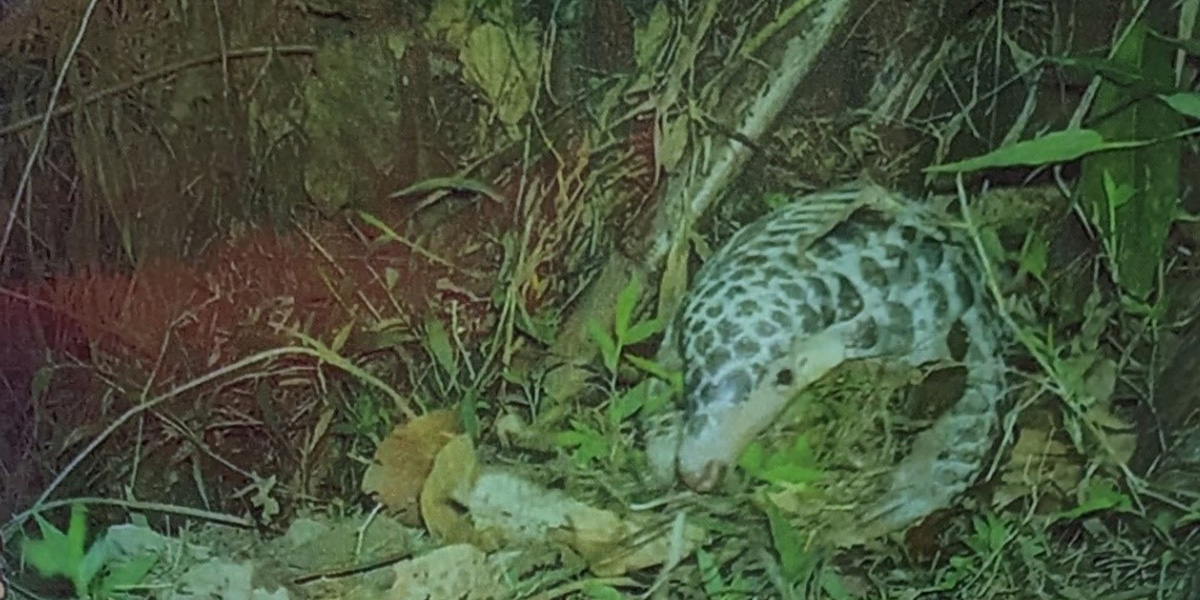
Among the six gifts, fallen leaves symbolize the pangolin practice of using fallen leaves to create a warm environment for nursing their young. The image shows a pangolin carrying fallen leaves into its burrow. (Provided by Tainan Community University)
Shared Story of Longci and Matoushan
The reason the Longci-Niupu Badland Geopark and the Mudstone Badland Geopark Kaohsiung became “in-laws” is that both parks belong to the same mudstone badlands and are geologically related. Italy and Georgia are the only other countries in the world that have such vast mudstone landscapes. As they are highly susceptible to erosion, they are considered badlands, unsuitable for agriculture. Back in the days, when waste management was scattered and disorganized, Longci and Matoushan became the designated landfill sites.
The residents of Matoushan established the Anti-Landfill Site Self-Help Society. Through their efforts, they set up automated cameras to overturn scholars' understanding of bamboo forests and discovered a rare land crab species, i.e., the geothelphusa ancylophallus, and a stable population of pangolins. As a result, they successfully established a geological park. Subsequently, it transformed into Matoushan Nature and Humanity Association for continuing community development. Longci badlands, on the other hand, have been a result of long-standing endeavor of the Tainan Community College and local residents. In 2019, the Executive Yuan declared that the landfill site development permit would not be extended after it expired. It was subsequently designated as a national geological park in 2021, temporarily preventing the establishment of landfill sites. With their geographic proximity and similar fate, Longci and Niupu are now “wed,” linking local protective forces and enhancing the integrity of the badland ecology.
Local Community Demonstrates Abundant Vitality
Finally, the six gifts and the pangolin welcoming party arrived at the Matoushan base. Elderly from local communities used traditional bamboo weaving techniques to create a 20-meter-long tunnel for the pangolin couple, decorated with photos of pangolin ecology and bamboo leaves. Organizations such as the Geoparks Association of Taiwan, Kaohsiung Wild Bird Society, South Neimen Community Development Association, East Neimen Community Development Association, the Highway Bureau - Third Division, Department of Geography at the National Taiwan Normal University, and Department of Anthropology at the National Taiwan University were also invited to the wedding and set up booths at the market fair. The wedding banquet was prepared by an environmental chef, Nuya Ahanah, featuring local ingredients and pangolin food culture, serving various dishes such as "ants climbing tree," dragon phoenix pastry, and bamboo shoot chicken soup to let everyone experience an authentic pangolin wedding feast.
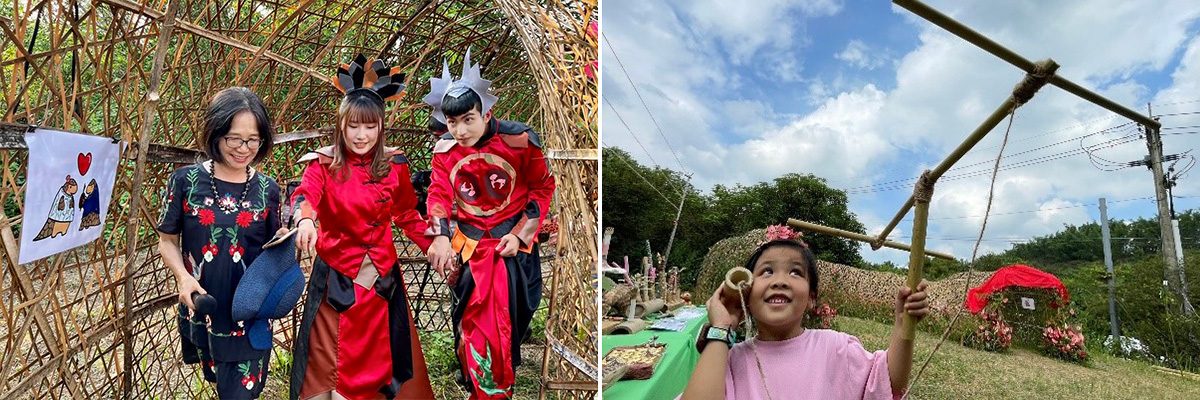
Right: Matchmaker Professor Shew-Jiuan Su leads the pangolin couple through a bamboo-made bridal chamber. (Provided by Tainan Community College)
Left: A girl using one of the six gifts, a bamboo tracking device, to simulate a tracking device for pangolins.
The highlight of the evening was the fashion show of students from the Department of Fashion Design and Merchandising at Shih Chien University, Neimen campus, showcasing costumes embodying local characteristics. The wedding attire for the pangolin couple was also created by students of Shih Chien University. The fashion show invited residents, professors, and government officials to model the garments, presenting a mix of elegant, avant-garde, and adorable styles, bringing a splendid ending to the pangolin wedding.

Professor Yueh-Fong Chen recounted the process of protecting the badlands on stage, emphasizing the need to strengthen the protection of the southwest badlands, a world-class landscape.
In the badlands of Kaohsiung and Tainan, this unique and peculiar wedding, with pangolins as the main characters, also served as an advocate for the badland conservation. Its significance lies not only in promoting the connection between badland landscapes and pangolin conservation, but also in the local cultural forces that protect the ecology, along with the involvement of government resources. This wedding ceremony has a remarkable impact on the protection of the badlands.
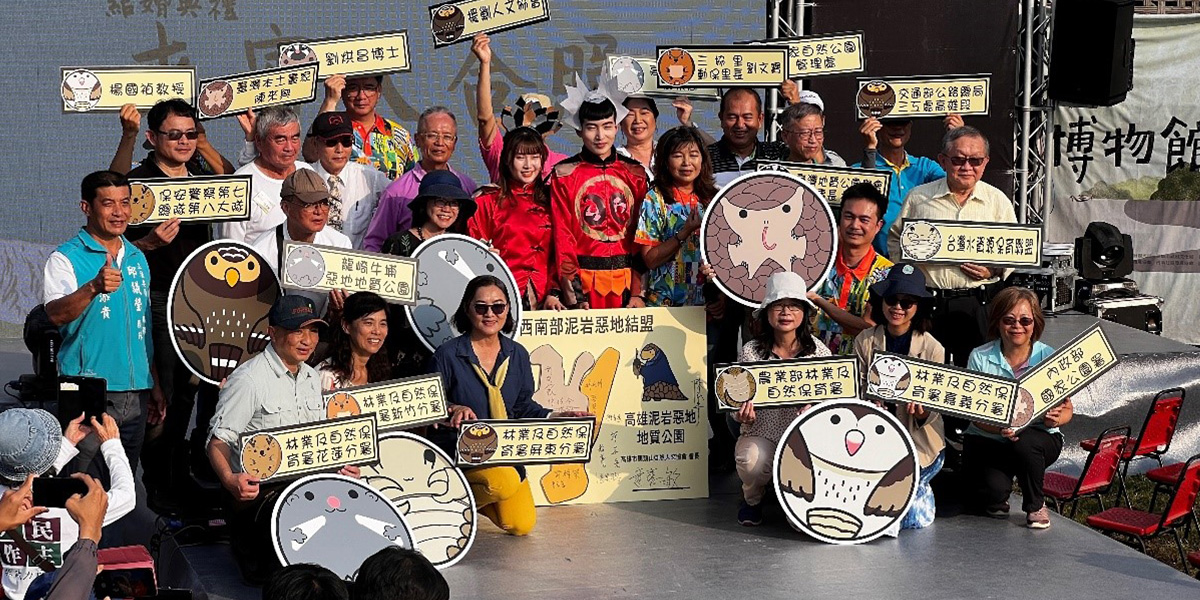
Representatives from various public and private sectors came on stage to sign up for the southwest mudstone badland alliance and took a group photo.
Supplemental Information on the Six Gifts for Pangolins:
First Gift: Taiwanese termite with termite mushroom
Taiwanese termites are one of pangolins' favored foods in nature. They would take back termite mushrooms to plant in their nests. Taiwanese termites need the termite mushroom mycelium to help digest plant tissues, while termite mushrooms need the ants' cultivation to compete with other fungi. These two have a close symbiotic relationship, and so they are combined as the first gift. When eating termites, pangolins do not empty the entire nest but leave a portion of the population behind, allowing the termites to reproduce, so that they can feed on the termites again later. This is an embodiment of sustainability wisdom of living organisms!
Second Gift: Cocktail Ant Nest
When disturbed, cocktail ants raise their abdomens and secrete formic acid as a defense mechanism, hence the name. Cocktail ants like to build nests on trees, which incidentally, making it easy for researchers to collect and feed them to rehabilitated pangolins.
Third Gift: Dog-Beating Stick
In addition to habitat loss, attacks by roaming dogs are one of the most common threats faced by pangolins because their defense mechanism is to curl up and remain motionless. However, their scales are not effective against the teeth of dogs. Therefore, the dog-beating stick was given as a gift, hoping that pangolins would not be disturbed by roaming dogs.
Fourth Gift: Longci Mudstone
The mudstone terrain distributed at the border of Tainan and Kaohsiung is an important habitat for the pangolins. The mudstone model represents Longci, the land that pangolin bride Xiao-qi would miss. It also symbolizes land protection and ecological preservation.
Fifth Gift: Pangolin Doll Bed
When pangolins reproduce, they carry fallen leaves to their nests to create a warm and suitable environment for nursing their young. Therefore, bamboo leaves and fallen leaves are used to create a doll bed symbolizing a comfortable environment for nursing pangolin babies, hoping that pangolins can reproduce safely and thrive.
Sixth Gift: Bamboo Tracking Device
To protect pangolins, Assistant Professor Ching-Min Sun of the Institute of Wildlife Conservation at National Pingtung University of Science and Technology cooperated with local residents to conduct long-term scientific investigations and health monitoring of pangolins. The Tainan Community College used local bamboo craftsmanship to replicate the shape of a radar tracking device used to monitor pangolins, as well as praying for the safety and health of every pangolin discovered by radars.




 中
中